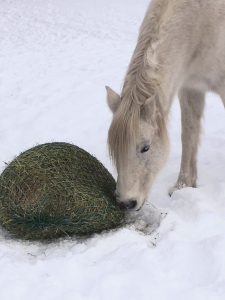Slow feeding helps to regulate and stabilize the hormonal dysfunctions that are often at the core of these illnesses. Extending or adding meals will not produce the physical and mental health benefits of free-choice forage.
Horses are trickle or slow feeders by nature. This means that they are biologically wired to thrive when they are continuously collecting and eating small amounts of long-stem high-fibre forage. This most basic realization is instrumental in keeping the horse healthy.
Forage is the foundation of every horse’s diet, and the forage needs to flow steadily through the digestive tract in order to avoid digestive problems. Horses’ stomachs, unlike that of the human, have evolved to produce hydrochloric acid continually, whether or not they are eating.
To offset the continuous secretion of hydrochloric acid in the stomach, the horse requires both a near-constant food source and a food source that requires a lot of chewing. Chewing stimulates the flow of saliva and the alkaline quality of saliva buffers gastric acids. Under natural conditions the horse will produce upwards of 25 or 30 litres of saliva every day.
Hindgut fermentation of fibre also relies on a steady influx of fibre. Ideally the fibre “porridge” that enters the hindgut will have been thoroughly chewed and mixed with saliva and other digestive enzymes. A healthy balance of hindgut fermentation is easily disrupted by gaps in forage flow. As long as the digestive “porridge” is buffered by saliva, contains adequate fibre and flows steadily, the horse’s digestive tract remains healthy.
Although gastric ulcers and colic are the most commonly recognized symptoms of gut distress in the horse, there are many symptoms of gut distress that go unacknowledged. These include, but are not limited to, general ill thrift, vices such as cribbing, weaving, aggression, feed anxiety, gorging, and choke.
Behavioural issues (because the horse is in pain) can also be rooted in gastrointestinal distress as the horse becomes mentally and emotionally unbalanced whenever its digestive system is not functioning well. The symptoms of gut distress can and often do negatively affect training, riding and performance programs. It is surprising and rewarding whenever these problems respond favourably to simply providing the horse with a steady access to free-choice forage.
Horses have an inherent drive to forage and whenever forage is restricted the horse becomes both physiologically and mentally distressed. This type of distress initially elevates cortisol levels and persistently elevated cortisol levels then initiate a problematic hormonal cascade for the horse.
Forage restriction is one of many factors contributing to metabolic conditions such as insulin resistance, equine metabolic syndrome, hypothyroidism and laminitis. Many of these conditions respond favourably to continual access of small amounts of low-energy (low-calorie) long-stem forage.
Horses that have continuous access to forage became mentally relaxed and calm. Over time they generally effectively “self-regulate” themselves, eating only what they need. As a result they are more apt to maintain a healthy body condition.
The slow-feeder industry has grown in response to the basic realization that horses have an inherent need to consume their forage diet slowly and preferably all day long. As their name suggests, slow feeders slow down the rate of forage availability to the horse.
Hay slow feeders employ either a mesh net or a grid system over the horse’s hay with holes that are fairly small, typically between 1-1/2 and two inches. There are many different styles and sizes of slow feeders, each with its own advantages. Systems vary from feeding flakes of hay in a bag on the ground or within a box system to the feeding of big round bales using a net system. Horses adapt quickly to the new program and often the benefits to the horse are observable within weeks of beginning to slow feed.
Whatever the design of the slow feeder, the feeding level is best kept as close to the ground as possible. A natural “foraging” position allows the horse’s mandible (jaw bone) to come down and forward into its proper position to spare stress in the upper neck and temporomandibular (TMJ) joints.
The mandible is then free to move up and down, side to side, and forward and backward without any restriction. This facilitates optimal movement and function of the dental arcade which in turn translates into proper chewing and preparation of the feedstuffs for the horse’s digestive tract. A natural head position further promotes effective drainage of nasal and respiratory passages.
Slow feeding is both a physiological and mental windfall for the horse. This simple change in the delivery of its forage averts a number of symptoms indicative of ill health.
Please contact us if any questions, our sales team will always be happy to provide you with the most professional info.

